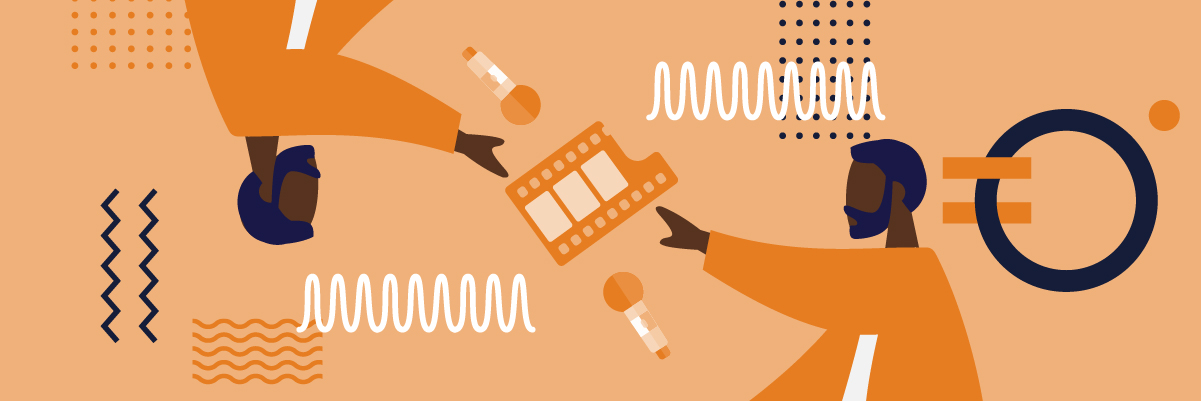ADR dubbing and dubbing in general are useful weapons in every content creator’s arsenal. We’ll examine each one. We’ll also take a look at the challenge of voice acting, prevalent in dubbing. Finally, we’ll figure out where we can get first-rate dubbing. Let’s get going.
ADR Dubbing: What is it?
Dubbing is essentially a post-production process in which recordings are lip-synced to an existing production.
ADR dubbing in particular means ‘automated dialogue replacement’. It’s the process of recording dialogue again, to be ‘implanted’, so to speak, into the original content. Such a recording may be created by the original actor or by a replacement actor.
There are different reasons why this process would take place. Some of the most common reasons include the following:
Improving the quality of a particular portion of the dialogue.
Re-recording because of poor sound.
Replacing the actor with an actor with particular vocal qualities.
Include changes in the script.
Improve diction or remove accents.
Remove content for legal purposes. This may include removing certain curse words to attain a particular rating.
Correct errors in pronunciation in the original recording.
What About Full Dubbing?
Full dubbing is a bit different to ADR dubbing. In the case of full dubbing, we’re talking about a longer process. In this case, we want to replace the voices of the characters completely, creating a new audio version.
Imagine that we have a film in English that we want to make accessible to a Spanish-speaking audience. We may very well choose to dub it. In this case, we would need to translate the script and assemble a voice cast. These actors would then re-voice the whole film, replacing the original voices with Spanish-speaking voices.

Example of ADR Dubbing and Full Dubbing
Throughout this article, we’ll provide tips and ideas to improve the voice acting process in dubbing. They’ll be related to the hypothetical dubbing of a film. Imagine that the talent you are directing/producing needs to dub a piece called ‘Hamlet for Kids’.
‘Hamlet for Kids’ would be a complex project. It would involve taking the original ‘Hamlet’ by Shakespeare and writing a script for an animated children’s film based on it. Such a script and film would be based on the original and created in English.
After such a transformation, there would be a need for dubbing for other markets. ADR dubbing would also be needed to smooth things out, should there be problems with the first recording.
What follows are a series of tips and tricks to succeed in an ADR dubbing or full dubbing situation like this one. They’re geared towards the directing and production of voice talent.
The Challenge of Characterization in ADR Dubbing and Full Dubbing
Voice acting is a challenging proposition. We must understand that voice acting, first and foremost, is acting. What this means is that when a voice talent goes inside the booth to dub content, they must provide a full performance that achieves the objectives of the story.
When trying to understand what it takes to dub a piece of content (whether ADR dubbing or full dubbing), we must observe the principles of good acting. Listed below are some essentials of acting, as espoused by two of the greatest coaches of all time: Stella Adler, who was Marlon Brando’s teacher, and the still living Larry Moss, a favorite coach of several stars.
The World of the Stage isn’t your World
Stella Adler begins her fantastic book ‘The Art of Acting’ by admonishing her students to understand the sheer size of performing. She states: “You have to understand that the theatre is epic. It’s large the way The Law is large, the way Family Life is large, the way growing trees are large – you must nurture them. You can’t neglect them.”
What Adler means is that performance should never to be taken lightly. On the contrary, performers must train as though they’ll be attempting big parts. She continues: “You’ll never really be great unless you aim high (…) You have to be ready (to play) ‘Death of a Salesman’. To play in the big plays your acting range, your stretch, your being, your lifeline has to be big.”
In the case of our fictional project ‘Hamlet for Kids’, this would mean several things. When casting the talent to create ADR dubbing, full dubbing and more we need to go big. This means:
Make sure your talent has the range to tackle the whole script.
When casting, go big. You may choose to cast the talent by using more complicated material. This will show their range and capacities.
The key is to make sure that the talent stretches to meet the demands of the voice parts. It’s best to figure this out early, in the casting process.
Acting is Doing
Adler wanted to impress on her students that acting wasn’t abstract. She stated: “Acting and doing are the same. When you’re acting you’re doing something, but you have to learn not to do it differently when you act it.”
This is an admonition to concentrate on actions. It is actions, and not abstract ideas, which constitute acting. This is particularly problematic in the case of voice acting. An ADR dubbing or full dubbing process needs to be particularly careful in this regard. Although a voice actor will be performing in the booth, their actions will eventually be completely auditory. Their voice is their tool and this usually means that these vocal actions must be big.
In many ways, voice acting resembles the theater, in that actors must usually go big, and capture the attention of their audience this way. Make sure your talent understands this.
The Actor Needs to be Strong
Acting, and certainly voice acting, requires tremendous strength. Adler continues: “For the stage you can’t have a voice that turns inward, a voice that mumbles. It’s better to have a voice that’s too big than one too small. If it’s too big you can always modify it.”
This is a fascinating piece of advice and one that’s directly relevant to ADR dubbing, full dubbing and voice acting in general. Voice acting resembles stage acting tremendously in this regard. The potency of the voice is vital, more so than in other productions (think a television actor for instance).
To this end, the voice talent we cast must strive to always develop their voice. Adler suggests a number of exercises for the stage actor, very relevant to voice actors too. These may be training exercises or warm-up exercises such as:
Reading a text and projecting the voice. Different variations may be experimented. The idea is to be able to project the voice, as though one were going to act for the stage.
Developing the Imagination
Even more than the physical assets that an actor brings (like their voice), imagination is key. Adler says: “Learn to stimulate the imagination. The imagination is what animates the instrument, keep it in tune. It’s the ignition key. Without it, nothing else works.” Adler is alluding to the intrinsic talent that an actor must have.
The imagination is certainly extremely important in any voice acting project, including ADR dubbing and full dubbing. In the case of the project we’ve been discussing, ‘Hamlet for Kids’, the voice talent would need to understand the original text and the new version. They would also need to carry it through in the recording booth, which is an altogether more demanding process than other types of acting.
Understanding the Text
Adler tries to impress the importance of the text on her students. She says: “The playwright gives you more than words. He gives you circumstances. Every play is written out of a social situation. If you don’t understand the social situation, you’ll be playing from a blind spot.”
What Adler is stating very well is the importance of the text. In the case of voice acting, this will usually be the script. This is certainly the case in the ‘Hamlet for Kids’ project that we’ve been discussing in this article. In the case of our fictional project, there are several layers of difficulty. For one, the source material of the script would be Shakespeare’s ‘Hamlet’. Such play is evidently a challenge in itself. The creators of ‘Hamlet for Kids’ would need to thoroughly understand the source material.
Understanding the text is not solely a challenge for the writers. Actors, and in our case, the voice talent, need to carefully study and master the text. An ADR dubbing, full dubbing or voice project in general requires a great understanding of the script.

Superobjective and Objective
Larry Moss is a phenomenal resource for any voice talent, director or producer attempting to create a voice acting project. About motivating each scene, and ultimately a story or script, Moss writes: “The objective of each individual scene is connected to your overall superobjective, your driving passion. The superobjective is the engine that propels you through the journey of the play or film; it is the dream that moves you through the story, for in plays and films as in life, without dreams we don’t take action.”
What Moss is explaining is that desire drives a character and drives a story. Each character has a specific objective in each scene. As we know, scenes lead to other scenes and eventually acts. The superobjective is that deep desire within each character that animates them throughout the duration of the script. These are crucial lessons when voice talent is confronted with the development of a character within the framework of a script.
Troubleshooting ADR Dubbing, Full Dubbing and Voice Acting
There are occasional hiccups when creating any voice acting project, including all types of dubbing.
Comedy isn’t funny!
Sometimes comedic scripts are a challenge for voice talent. Despite their best efforts, the script just doesn’t seem funny. The obvious correction is to go back to basics, and revisit the writing process.
If the script is working, there are some fixes that may be applied at the voice acting level. Larry Moss provides some excellent advice in this regard:
Find the rigidity in the character you’re playing.
Always play the human truth and believe in the character’s stakes.
Tailor your acting choices to the style of the text and the production.
Comic behavior reveals character.
The Bunny Studio Way
Bunny Studio can help out in any ADR dubbing or full dubbing process, as well as in all voice acting projects.
Simply contact Bunny Studio for all your dubbing needs. Our staff will be happy to help! Let’s get your project going!










